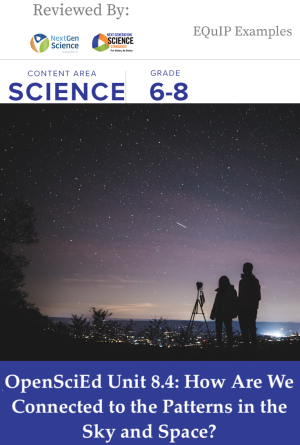
OpenSciEd is a nonprofit organization that brings together educators, philanthropic organizations, curriculum developers, and professional development providers to improve science education through the development and implementation of high-quality, freely available science instructional materials. While this work has begun at the middle school level with Grades 6 through 8, the goal of OpenSciEd is to ensure that all educators, from elementary to high school, have access to a free, coherent, rigorous, research-based set of instructional materials that will support all students in meeting the vision for science literacy described in A Framework for K-12 Science Education and the Next Generation Science Standards.
Score: 8
Awarded the NGSS Design Badge
Science Discipline: Earth & Space Sciences, Physical Sciences
Length: Unit
Year Reviewed: 2021
Humans have always been driven by noticing, recording, and understanding patterns and by trying to figure out how we fit within much larger systems. In this unit, students begin observing the repeating biannual pattern of the Sun setting perfectly aligned between buildings in New York City along particular streets and then try to explain additional patterns in the sky that they and others have observed. Students draw on their own experiences and the stories of family or community members to brainstorm a list of patterns in the sky. And listen to a series of podcasts highlighting indigenous astronomies from around the world that emphasize how patterns in the sky set the rhythms for their lives, their communities, and all life on Earth, and these are added to their growing list of related phenomena (other patterns in the sky people have observed).
In the first two lesson sets (Lessons 1–5 and 6–7), students develop models for the Earth-Sun and Earth-Sun-Moon systems that explain some of the patterns in the sky that they have identified, including seasons, eclipses, and lunar phases. In the third lesson set (Lessons 8–12), students investigate a series of related phenomena motivated by their questions and ideas for investigations. In the final lesson set (Lessons 13–17), students explore the remaining questions on their Driving Question Board, related to planets and other objects farther out in space (beyond the stars they can see with the unaided eye).
Link to Materials
The following link will direct you to OpenSciEd’s Unit 8.4: OpenSciEd Unit 8.4 How Are We Connected to the Patterns We See in the Sky and Space?
The NGSS Design Badge is awarded only to the version of this unit that was reviewed. If any modifications are made to this unit, the revised version cannot be promoted as having earned the badge.
 Reviews & Questions
Reviews & Questions
No comments submitted